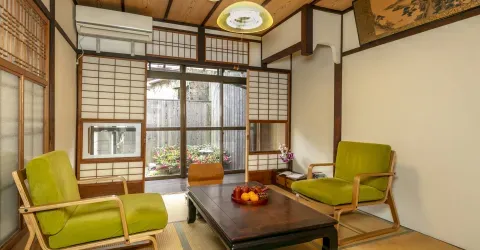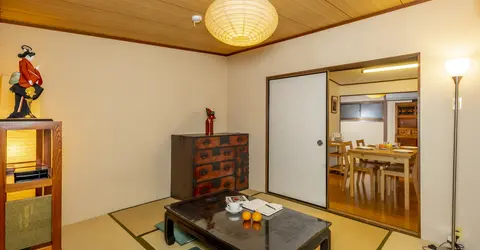Shoseien Garden: A hidden gem of Kyoto's rich cultural heritage
- Published on : 01/05/2024
- by : Japan Experience
- Youtube

Chinese-corridor style Bridge (Kaito-ro), Shoseien Garden, Kyoto
Nestled in the heart of Kyoto, Shoseien Garden stands as a testament to Japan's exquisite garden design and rich cultural history. This hidden oasis, also known as Kikoku-tei or the "Trifoliate Orange Villa," is a detached garden belonging to the nearby Higashi Honganji Temple. Spanning an impressive 33,000 square meters, Shoseien offers visitors a tranquil escape from the bustling city life. With its meticulously crafted landscapes, serene ponds, and historic buildings, the garden provides a unique glimpse into the aesthetic principles of Japanese garden design. Whether you're a history enthusiast, a nature lover, or simply seeking a moment of peace, Shoseien Garden promises an enchanting experience that captures the essence of traditional Japanese culture.
History and origins of Shoseien Garden
The roots of Shoseien Garden stretch back to the 9th century, during the Heian Period. Originally, it is believed to have been part of the estate of Prince Minamoto Notoru, son of Emperor Saga. This connection to imperial history adds a layer of prestige to the garden's already rich background. However, the garden as we know it today began to take shape in the 17th century.
In 1641, a pivotal moment in Shoseien's history occurred when Shogun Tokugawa Iemitsu granted the land to the nearby Higashi Honganji Temple. Two years later, in 1643, the 13th abbot of Higashi Honganji, Sennyo (1604-1658), commissioned the creation of the garden. The design was entrusted to Ishikawa Jozan (1583-1672), a renowned ex-samurai, Confucian scholar, and poet. Ishikawa's expertise in garden design is also evident in another famous Kyoto garden, Shisendo in Higashiyama.
Unfortunately, Shoseien faced significant challenges during the turbulent Edo Bakumatsu Period. In 1858 and again in 1864, fires ravaged the garden, destroying many of its structures. However, the resilience of those who cherished the garden led to its restoration. In recognition of its historical and cultural significance, Shoseien was designated as a National Historic Site in 1936, ensuring its protection and preservation for future generations.
Layout and key features of the garden
Shoseien Garden is a classic example of a "chisen-kaiyu" style garden, where visitors follow a circular path around a central pond. This design allows for a constantly changing perspective as one strolls through the garden, revealing new vistas and hidden corners at every turn. The garden's layout is carefully crafted to create a harmonious balance between nature and human-made elements.
At the heart of Shoseien lies the Ingetsu-chi, a large central pond that serves as the focal point of the garden. The pond is home to colorful koi carp and attracts various species of ducks, including mallards, pintails, spotbills, and teals. Surrounding the pond are meticulously maintained walking paths that guide visitors through the garden's numerous attractions.
One of the most striking features of Shoseien is its collection of tea houses, each offering a unique view of the landscape. These include:
- Rinchi-tei and Tekisui-ken Reception Halls
- Shukuen-tei Tea House
- Tairitsu-seki Tea House
- Ro-an Tea House
- Sochin-kyo Tea House
The garden also boasts several remarkable bridges, including the Shinsetsu-kyo (Snow-Capped Bridge) and the Kaito-ro (Chinese-corridor style Bridge). These structures not only serve a practical purpose but also add to the aesthetic appeal of the garden.
Other notable features include the Onrin-do Hall, which houses a Buddhist altar, and the Boka-kaku Pavilion, a unique two-story structure with steep staircases on both sides. The garden is also adorned with numerous stone lanterns, adding to its serene atmosphere.

Snow-Capped Bridge, Shoseien Garden, Kyoto
Cultural significance and artistic inspiration
Shoseien Garden holds immense cultural significance as a living testament to Japanese garden design and aesthetics. Its creation during the Edo period reflects the Kamakura Period principles of garden design, which emphasized the recreation of natural landscapes in miniature form. The garden serves as a physical embodiment of Japanese philosophical and spiritual concepts, inviting contemplation and reflection.
Throughout its history, Shoseien has been a source of inspiration for artists, poets, and scholars. The garden's changing seasonal beauty has been captured in countless paintings and poems. Its tranquil atmosphere and carefully composed landscapes continue to inspire visitors, offering a space for meditation and creative thought.
The garden's connection to Buddhism, through its affiliation with Higashi Honganji Temple, adds another layer of cultural significance. It serves as a physical representation of Buddhist principles, with elements like the central pond symbolizing the journey of life and the bridges representing the path to enlightenment.
Moreover, Shoseien's role as a reception area for important guests throughout history highlights its importance in Japanese diplomatic and cultural exchanges. The garden has hosted numerous dignitaries, including Emperor Meiji, court nobles from Tokyo, and even Russian diplomats, serving as a showcase of Japanese culture and aesthetics to both domestic and international visitors.

Water lilies, reminiscent of a painting by Monet, Shoseien Garden, Kyoto
Visiting Shoseien Garden: Practical information and tips
For those planning to visit this hidden gem, here's some essential information to ensure a smooth and enjoyable experience:
Location and Shoseien Garden Access: The garden is conveniently located near Kyoto Station, making it easily accessible for both locals and tourists. It's about a 10-minute walk from the station, situated just east of Higashi Honganji Temple.
Opening Hours: - March to October: 9:00 AM to 5:00 PM (last entry at 4:30 PM) - November to February: 9:00 AM to 4:00 PM (last entry at 3:30 PM)
Admission Fee: 500 yen for adults, 250 yen for high school students and younger
Best times to visit: While Shoseien is beautiful year-round, early morning visits often provide a quieter, more serene experience. Weekdays are generally less crowded than weekends.
Facilities: There are restrooms available on site. However, please note that there are no food facilities within the garden, so consider bringing water, especially during hot summer months.
For a more immersive experience, consider joining a guided tour or renting an audio guide to learn more about the garden's history and features. Don't forget to check out the Shoseien Garden Map to plan your route through the garden effectively.
Seasonal highlights and best times to visit
Shoseien Garden offers unique beauty in every season, making it a year-round destination for nature lovers and photography enthusiasts. Here's what you can expect throughout the year:
Spring (March to May): This is perhaps the most popular time to visit, thanks to the blooming cherry blossoms. The garden's plum orchard comes alive with red and white blossoms in February, followed by snow willows in March, and then the iconic cherry trees in April. The sight of delicate pink petals reflected in the pond is truly breathtaking.
Summer (June to August): While the heat can be intense, summer brings its own charm to Shoseien. The garden becomes a lush green oasis, with Azaleas blooming in May and water lilies gracing the pond in the warmer months. The sight of these flowers, reminiscent of Monet's paintings, creates a serene and picturesque scene.
Autumn (September to November): Fall is another spectacular season at Shoseien. The garden's maple trees turn fiery shades of red and orange, creating a stunning contrast with the evergreen pines. Bush clover blooms in September and October, adding to the autumnal palette.
Winter (December to February): While colder, winter offers a unique perspective of the garden. On rare occasions, snow may dust the landscape, transforming Shoseien into a winter wonderland. The bare branches of trees reveal the garden's underlying structure, highlighting its careful design.
For photographers, early morning or late afternoon visits can provide the best light for capturing the garden's beauty. Remember, the garden's appearance changes not just with the seasons, but also throughout the day, so multiple visits can offer new perspectives and experiences.

Shoseien Garden's connection to Higashi Hongan-ji Temple
Shoseien Garden's history is intrinsically linked to Higashi Hongan-ji Temple, one of the most important temples of Jodo Shinshu Buddhism in Japan. The garden serves as a detached part of the temple complex, located just a few blocks away from the main temple grounds.
The connection between Shoseien and Higashi Hongan-ji dates back to 1641 when the land was granted to the temple by Shogun Tokugawa Iemitsu. Since then, the garden has played a significant role in the temple's history and functions. It has served as a retreat for the temple's abbots, a place for contemplation and meditation, and a venue for important ceremonies and receptions.
One of the garden's alternative names, Kikoku-tei or "Trifoliate Orange Villa," comes from the hedge of Japanese bitter orange trees that once surrounded the garden, symbolizing its connection to the temple. The garden's design and features, including its Buddhist halls and tea houses, reflect the aesthetic and spiritual principles of Jodo Shinshu Buddhism.
Today, Shoseien continues to be maintained and operated by Higashi Hongan-ji Temple. Visitors to the garden are encouraged to also visit the main temple complex to fully appreciate the historical and spiritual context of Shoseien. The temple's website (www.higashihonganji.or.jp) provides additional information about both the temple and the garden, although mostly in Japanese.

Preservation efforts and modern-day significance
Shoseien Garden's designation as a National Historic Site in 1936 marked a significant step in its preservation. This status has ensured that the garden receives the necessary care and protection to maintain its historical and cultural integrity. Over the years, various restoration projects have been undertaken to preserve the garden's structures and landscapes.
In recent years, there has been a growing emphasis on sustainable garden management practices at Shoseien. These efforts include careful water management, preservation of native plant species, and environmentally friendly pest control methods. The garden serves as a living laboratory for traditional Japanese gardening techniques, helping to preserve these skills for future generations.
Shoseien also plays a crucial role in promoting cultural understanding and appreciation of Japanese garden art. It serves as an educational resource for students of landscape architecture, horticulture, and Japanese culture. The garden regularly hosts workshops and events that allow visitors to engage more deeply with Japanese garden traditions.
In the context of modern Kyoto, Shoseien stands as a vital green space in the urban landscape. It provides a peaceful retreat for both locals and tourists, offering a space for relaxation, contemplation, and connection with nature. As Japan Parks & Gardens face increasing pressures from urbanization and climate change, the preservation of historic gardens like Shoseien becomes ever more important.
As we look to the future, Shoseien Garden continues to evolve while staying true to its historical roots. It stands as a living testament to Japan's gardening traditions, a peaceful oasis in the heart of Kyoto, and a bridge between past and present. Whether you're a first-time visitor or a regular guest, Shoseien Garden offers a timeless experience of beauty, tranquility, and cultural richness.




























